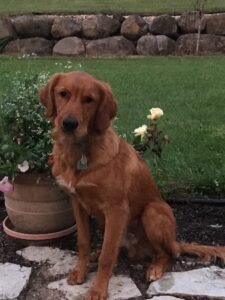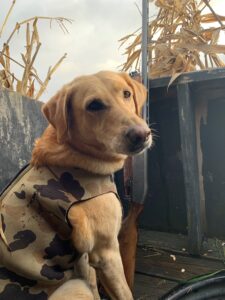An article from WWA’s Doctor’s Orders
 By Dr. K.C. Brooks, an avid waterfowler, dog lover and practicing veterinarian at Lodi Veterinary Care.
By Dr. K.C. Brooks, an avid waterfowler, dog lover and practicing veterinarian at Lodi Veterinary Care.
This article originally appeared in Wisconsin Waterfowl Association’s May, 2022 eNewsletter.
The time was 5:40 am, a full twenty minutes before my internal alarm clock would be ending a peaceful night of sleep. A cold, wet nose on my arm interrupted my dreams. It was Azzel, my three-year-old Golden Retriever, letting me know that the sun was about to rise. For him that meant it was time for our morning walk. The bedroom was otherwise quiet. Jojo, the eight-year-old Lab, was content to be curled up on her blanket dreaming of retrieving a limit of ducks in warm, calm water. Bernie, our fifteen-year-old Shih tzu, was sound asleep on his bed. He had departed our bed sometime earlier in the morning. Azzel, though, had other ideas. He would not settle for dreaming of retrieves, he was set on practicing retrieves. While I could have briefly ignored him, I knew he would eventually persist. Since I was essentially awake, I decided to get an earlier start on our “training” session.

Azzel Brooks
This routine had started innocently as a commitment on my part to get a morning walk in before my day got going. I realized that I could benefit from a brisk thirty-minute walk and the dogs were eager to join me. I soon discovered that the walks meant more to Azzel than they did to the rest of us. For me, it was a way to burn a few calories and clear my head before really starting my day. For Jojo, it meant a chance to search for any morsel of an edible object that she could consume before breakfast. For Bernie, it meant that he could take my place in the bed next to mom without anyone touching him. For Azzel, it meant a chance to practice pleasing me. Initially our walks were a routine stroll around the perimeter of our farm with the dogs running freely and checking in periodically. Eventually Azzel decided that bringing me objects that I might toss for him to retrieve was more fun than just running. It all started with sticks. He is obsessed with sticks. He then progressed to anything he felt could satisfy his retrieving urge. The biggest prize so far that he has discovered was a half-rack shed of a beautiful 10-point buck that he found on the prairie.
It finally dawned on me that our morning walks could be turned into real training sessions and I would be able to kill two birds with one stone. I could still get it my walk, but Azzel could get some much-needed training on a consistent basis. I started to be more intentional about preparing for our walks. I added a whistle to my wardrobe and decided to carry a couple of training dummies in an over-the-shoulder bag. The first ten minutes of our walks continued to be about running free and burning off energy but then they became pseudo training sessions. We practiced heeling (not Azzel’s strong suit), sit-stays, down-stays and recalls while I continued to get my exercise. It is easy for me to practice “mini-blind retrieves” by dropping a dummy when he is not looking and then giving him the “dead bird” command. A few short, easy marks mixed in with this routine helps reinforce the need to be steady and the difference between marks and blinds. Along the way, I toss several bumpers that he is not allowed to retrieve in hopes of keeping him steady when the real excitement builds in the blind this fall.

Jojo Brooks
Of course these sessions don’t take the place of regular, planned, training sessions designed to work on specific skills a retriever needs to become accomplished at their trade. What I have discovered is that these “training walks” really set the table for more productive training sessions when we had time for them. Importantly, they happen consistently and we all know that like any other athlete, real improvement comes mostly in the off season. Spring is the best time to get a jump on that training. The water is open and the days longer. The weather is not so warm as to limit activity and the cover not too thick to challenge young dogs. It is the perfect time to get a head start on taking off the winter pounds (for both dog and owner) while building some endurance for the long hunting days. Unfortunately, spring is also the time that the ticks return with vengeance. It is therefore very important that you are sure that your dogs are protected with appropriate tick preventatives. This will keep them from suffering from the nasty tick-borne diseases like Lyme and Anaplasmosis.
Spring is a time of renewal. Make this spring the start of your best hunting season ever. Be sure your dog is involved in regular training and fitness sessions. Doing so will ensure that they will be adequately prepared to perform to the best of their ability this coming fall. The benefits will become obvious to both you and your dog. Enjoy your dog!
